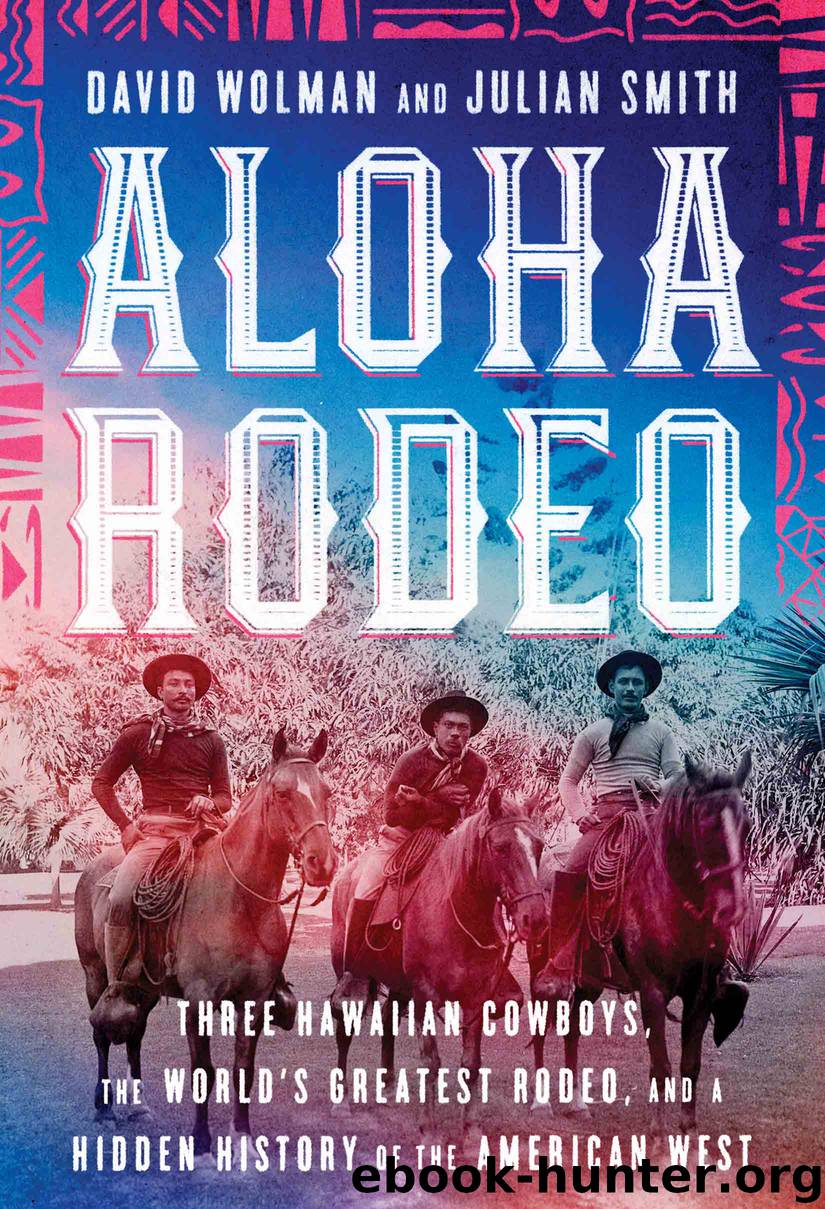Aloha Rodeo by David Wolman

Author:David Wolman
Language: eng
Format: epub
Publisher: HarperCollins
Published: 2018-04-07T16:00:00+00:00
9
Cowboy King of the Islands
THE GUARD WITH A sawed-off Winchester across his lap sat on the front seat of the rolling stagecoach, eyes alert for trouble. Even so, the small party of pioneers inside never stood a chance. A group of mounted Indians was lying in ambush, waiting for just the right moment.
With piercing war cries, the braves gave chase, and the sounds of the ensuing gunfight echoed up and down the beach. They soon overtook the coach, disarmed the guard, and bound their captives. The attackers rifled through the victims’ belongings and made preparations to dispatch the God-fearing homesteaders. Then, just when all seemed lost, a group of U.S. cavalrymen arrived to deliver a thunderous counterattack. Clouds of gunpowder smoke filled the tropical air, the Indians fled, and the thankful captives were saved.
The dramatized stagecoach holdup was exemplary Wild West theater, and the spectators gathered that afternoon in December of 1905 at Honolulu’s Kapi‘olani Park ate it up. Early twentieth-century Hawaii, like much of the world, was caught up in frontier fever.
Shows popularized by Buffalo Bill Cody had conquered the Americas and Europe, spreading an image of the West that was so vivid, so specific, that even people living an ocean away had little patience for imitators. A performance in Honolulu a few years earlier received scathing criticism before it even opened. The papers warned that the show would deliver a hippodrome without chariots and a Wild West show without American Indians—little more than “a circus tent and a few shabby costumes.” The inauthenticity reeked. Apparently the event’s organizer “imagines Honolulu people are not aware of this fact—but they are.”
As Isabella Bird had seen during her visit in the 1870s, riding had become enormously popular in the islands, even outside the world of the paniolo. Hawaiians rode for transportation and fun, swinging polo mallets on grassy fields and racing anywhere there was room. On June 11, 1872, horse racing was part of the festivities at the Kamehameha Day holiday celebration. The Hawaiian Jockey Club was established that same year, and soon racetracks, like the one at Kapi‘olani Park on the edge of Waikiki Bay, had been cleared on patches of flat ground throughout the islands.
It was only natural that Hawaiians wanted to see paniolo compete in riding and roping contests. An early example, from 1896, was billed as an “Amusement Carnival,” with ads promising “scenes in the wild west” on a baseball field in Honolulu. Other horse-racing events began to feature “bona fide cowpunchers.” The Jockey Club usually hosted races for club members only, but in 1902 it held a three-mile relay race for cowboys, although “natives” were encouraged to participate. That winter, employees of island ranches competed against one another in contests held on New Year’s Day. (Parker Ranch paniolo had taken up a collection for the prize money.)
Hilo’s 1903 Fourth of July festivities included horse races and a cowboy tournament that was one of the first demonstrations of roping and bronco riding in Hawaii. The controlled setting
Download
This site does not store any files on its server. We only index and link to content provided by other sites. Please contact the content providers to delete copyright contents if any and email us, we'll remove relevant links or contents immediately.
Obsessed by Wildfire by Autumn Jordon(745)
Cowboy Skills by Stephen Brennan(711)
The Biggle Horse Book by Jacob Biggle(696)
Horses Never Lie by Mark Rashid(681)
Aloha Rodeo by David Wolman(651)
The Pastures of Beyond by Dayton O. Hyde(633)
The First Stampede of Flores LaDue by Wendy Bryden(496)
Fried Twinkies, Buckle Bunnies, & Bull Riders by Josh Peter(405)
Stormy The Barrel Horse by Ralph Galeano(377)
Horsemanship Through Life by Mark Rashid(341)
Obsessed by Wildfire(129)
Meeting of the Mustangs by Cathy Kennedy(77)
Chilcotin Yarns by Bruce Watt(43)
Bull Rider by Carpenter Maggie(39)
His Crazy Cowgirl: A Contemporary Western Romance by Maggie Carpenter(22)
